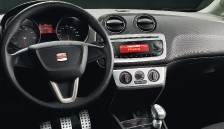Switches, buttons and indicator stalks may all soon disappear in sweeping dashboard changes being engineered as part of moves to raise the standard of motoring safety.
By as early as 2012, all the features they manage could be coming under the direct command of drivers’ voices.
While automatic transmission, satellite navigation and a plethora of assistance systems have turned operating the family car into child’s play, evidence is mounting that the proliferation of instrument panel gadgetry is threatening safe travel by distracting drivers.
Intensive development work is under way to replace traditional switchgear with systems that call for less attention from the person behind the wheel – and progress toward the next-generation instrument panel has already reached an advanced stage at Seat.
“We belong to the generation that has seen the biggest change in technology and I can tell you that we are well on the way with this – I think we will be ready with it in three years’ time,” design director Luc Donckerwolke told AM.
Based in Martorell, near Barcelona, Donckerwolke’s design team is concentrating on using just two new systems to replace most instrument panel functions.
“What I’m thinking of is voice control and a small frame mounted by the driver’s side, designed to incorporate elements to guide the fingers. What we need is a single operating standard for all the various components and I believe this is not that far away from reality.
“You could have slots where your finger could slide and the function of the slots could be changed. For example, we could switch on the lights or operate the wipers just by sliding a finger across the slot. You could go further and it could operate the radio. There could be a voice input and the slider would reconfigure so that it dealt with the window function or other things.
“This is my vision and the key is to make it intuitive, otherwise you have lost all the potential benefits. I’d like to see this operating system applied to every car,” he said.
Donckerwolke is serious about the dangers of driver distraction. “The first element of safety is active, about concentrating on driving and helping avoid accidents in the first place, so the architecture of the dashboard is a big element.
“On the latest Ibiza model, the dash is slanted forward to force the eyes toward the front of the car: I’m trying to avoid too many lines and concentrate elements so vision is not blocked by the black panel of the radio or the air conditioning control.
“What I really want is to get rid of all instrumentation and screens. People want big screens and I’m telling them to forget it because less is more – we need reduction.
I want an interface that is tactile. I want people to be able to operate systems without having to look down. The problem with touch screens is that you have to look at them – I love the iPhone, but try sending an SMS from one while driving and it creates problems. It’s just the same when you force people to look at a dashboard screen.
“I believe we have to landscape the inside of a car to be tactile and operate via voice recognition. We have been influenced by the aero industry, but people in planes don’t have to watch for green lights or look out for pedestrians, so we need to step back and think differently.”
Added Donckerwolke: “The interior of a Lamborghini has to be like a jet fighter and designed to keep you concentrated at 200mph. In that situation, an aftermarket radio is an absolute nonsense because it has buttons and things that are distracting.
“That philosophy should apply to all cars. If it’s good for a car that does 200mph, it will be much better for the ordinary car and the family motorist. It’s up to us to make sure that everybody is safe from the very first time they drive. It is our responsibility to make it attractive but extremely safe.”
Simpler operation needed
The rationale behind the need for a rethink on controls in cars wins enthusiastic support from Keith Ryder, assistant director of design at Peugeot in France.
He told AM: “There’s no doubt that things need to change. A car is a potentially dangerous machine and we have to respond to the need to make it simpler to operate.
“I’m all in favour of voice activation – this is a good move because it would cut out fiddling with controls and would create a much safer driving environment.
“I’m sure in future we will have sensors that make the car respond automatically to speed zones and this should also result in a big improvement in safety. But in ridding ourselves of certain controls, we need to be selective in what we keep and how we treat it. It’s important we avoid visual pollution because interiors are an important part of upgrading the
perception of the brand.”
Ryder added: “I believe the simpler a dashboard is, the better it works. We could do all kinds of things with a fascia that didn’t have buttons and switches. I can image all kinds of developments for interiors if that was the case, and if all the new control gear can be simplified and properly packaged, it will be a huge step forward.
“Take a look at cars from the 1950s and 1960s: they used to have dashboards that were planks with a few dials and rocker switches and they were fantastic.”
Please click here to download the Essential Technology Feature.















Login to comment
Comments
No comments have been made yet.